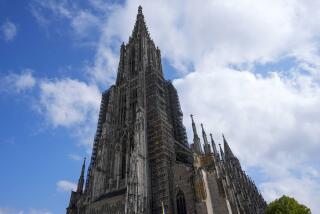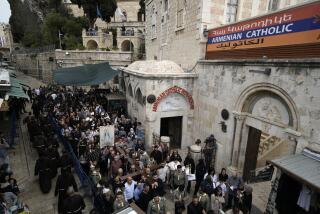Holy Sepulcher Guardians Slam Door on Portal Plan
- Share via
JERUSALEM — Pushing through the single, medieval portal of the Church of the Holy Sepulcher, worshipers, priests and pilgrims jostle for space. Smoky perfumes of frankincense and myrrh mingle in the air. The flickering light of hundreds of candles bounces off gilded mosaics and silver chalices. Rhythmic liturgical chants in Latin, Greek, Aramaic and other ancient tongues echo and clash through the cool, dark chambers of Christianity’s most sacred shrine.
Any morning inside the Church of the Holy Sepulcher is an assault on the senses, an experience in otherworldly rapture for the deeply pious--and a confusing mess for the less spiritually moved.
For this is where most Christians believe Jesus was crucified, buried and resurrected. No fewer than six Christian denominations physically share this holiest of churches, and its hodgepodge of architecture, decoration and ceremony reflects centuries of turbulent competition among the faiths for domination and control.
Millions of visitors to Jerusalem count the Church of the Holy Sepulcher as their most important destination, and with the advent of the millennium, millions more are expected to make the pilgrimage.
And that is exactly what has Israeli authorities worried. The church has just one entryway, a heavy wooden door about 6 feet wide and hundreds of years old. So far, despite months of negotiation, the authorities have failed to persuade the church’s Christian guardians to open a planned second door in time for the anticipated millennium crush.
It is a disaster waiting to happen, Israeli government officials say.
But the government is also reluctant to impose an emergency exit on the church. Israel is already in hot water with the Christian world because of its decision to allow construction of a mosque near another Christian shrine in Nazareth, the town of Jesus’ boyhood. Even the Vatican has reacted with uncharacteristically blunt fury.
The denominations that control the Holy Sepulcher have likewise made it clear that they do not welcome Israeli interference.
“We do not recognize Israeli sovereignty over East Jerusalem,” said Wadi abu Nassar, a spokesman for the Latin, or Roman Catholic, patriarch. And, he added, a new door could be seen as tipping the balance of power among the churches.
Indeed, the denominations’ mistrust of Israel is second only to their mistrust of one another.
Three main religions--Roman Catholic, Greek Orthodox and Armenian--have principal custody of the church under an edict issued in 1852 by the ruling Ottoman sultan and known as the Status Quo. Three additional denominations, Coptic, Syrian Orthodox and Ethiopian Christian, are given space within the church, portions of which date to the 4th century.
The jealousy with which each faction guards its interests, status and turf is legendary. Disagreement has blocked or delayed even the most fundamental renovation projects. The purported tomb of Christ, the centerpiece of the church, remains encased in rusted scaffolding erected more than half a century ago by British Mandate governors seeking to repair earthquake damage. The factions cannot decide how to go about removing the scaffolding, even though it is a harsh blemish on the one feature that pilgrims will queue for hours to behold.
“The timetable of the churches is not the timetable of the modern world,” said Uri Mor, the Israeli government’s liaison to the Christian community and a principal proponent of opening a new door. “It took them 30 years to agree to paint the cupola. It took another 30 years to repair some of the arches. So now we don’t have 30 years, maybe only two months, but I think they understand the situation.”
Israel has a responsibility to guarantee the safety of visiting pilgrims, Mor said, but also must enforce the Status Quo, maintain the delicate balance that exists within the church and respect the will of the denominations. Unilateral action by Israel would also stir the wrath of Yasser Arafat’s Palestinian Authority, which maintains its own claims for influence over the holy shrines.
As the controversy over the door shows, the Church of the Holy Sepulcher is really a metaphor for the region, where historically adversarial peoples crammed in a small space struggle for a share of land and power. No faction is willing to cede anything that might take away from its own position or give another faction advantage.
“You might say it’s childish, that it’s un-Christian,” said Daniel Rossing, an expert on interfaith relations and the Holy Sepulcher. “But this is the reality of Jerusalem.”
Under the Status Quo agreement, the congregations that control and worship in the Holy Sepulcher follow a detailed schedule for their Masses and rituals, down to when the Ethiopians can scatter incense and where the Greeks can hang icons. It divides the real estate of the Holy Sepulcher column by column, stone by stone.
One wide marble column, behind Jesus’ tomb, is quite literally half Greek Orthodox, half Armenian.
“They constantly work out ways so that everyone can say, ‘It’s mine,’ ” said Rossing, former head of the Christian Department in the Israeli Religious Affairs Ministry. “It is a playing of games. But it works.”
Rossing and others note that the Christian denominations are minorities in the Middle East and feel besieged in a battle to preserve their cultural, linguistic, liturgical and ethnic traditions.
“The mind-set is that if I give up an inch, then that’s it. It’s over,” Rossing said. “And then, of course, look at the real estate that’s involved. It is not just any door, not just any step. It’s the Holy Sepulcher.”
And so, although the churches agreed in November 1998 to construct an emergency door, probably in an area controlled by the Greeks, they have yet to agree on the details: In what direction should its corridor lead? Through the Copts’ chapel or through the Ethiopians’ rooftop Deir al Sultan area? Who should get the keys? Who will decide what constitutes an emergency?
Mor asked a committee led by Internal Security Minister Shlomo Ben-Ami to make the decisions. But the committee, unwilling to impose a ruling on the churches, punted. Ben-Ami is holding meetings with various church leaders in search of a compromise.
“If they do not agree on a door, then the police may not have any choice but to limit the number of people who can enter,” Mor said.
The nightmare scenario that he fears could occur with the annual Eastern Orthodox Easter Ceremony of Fire. Every year, about 17,000 worshipers crowd into the church to watch their patriarch emerge from Jesus’ tomb with a blazing torch. He then lights thousands of candles held aloft by the packed pilgrims. Once last century, a fire broke out that killed an estimated 500 worshipers.
Dilapidated and divided, the Church of the Holy Sepulcher is sandwiched between mosques and souvenir kiosks in the Old City. Pilgrims trace the route fabled as Jesus’ final path, the Stations of the Cross, often carrying replica wooden crosses on their backs. They end up at the Holy Sepulcher.
Inside, crowds of worshipers stop to pray at the Stone of Unction, representing the place where Jesus’ body was anointed with aloes and oils after his crucifixion. A woman goes by on her knees. Another is prostrate. A Norwegian Cruise Line tour group steps gingerly by her while a Franciscan friar in cassocks keeps the lines moving.
A narrow half-circle of steep stairs leads to two chapels, one Catholic, one Greek Orthodox, stacked over the purported Rock of Golgotha, where tradition holds that Christ was nailed to the cross. A visitor need step only feet to go from Byzantine mosaics to Armenian tiles to ancient Jewish graves.
It is a cacophony of sights, sounds and smells, more peculiar than beautiful, more aggressive than tranquil.
A British pastor, overwhelmed by the jumble around him, stopped his small tour group for prayer during a visit the other day. “Lord,” he began, inhaling deeply, “we rejoice in all the ways you can be worshiped. And at the same time, we take sorrow in all these signs of human frailty.”
During the time of the Crusaders, the Church of the Holy Sepulcher had a dozen or so doors. The Muslim warrior Saladin recaptured Jerusalem in 1187, ending the Crusaders’ reign. He expelled them but allowed some Christian priests to continue to work from the church. However, to keep tabs on who entered the site, he ordered all its doors sealed save half of the main portal.
In addition, he entrusted the single key to the single door to a single Muslim family, ensuring control over access--and avoiding having to favor either Latin or Eastern Christians. To this day, the Joudeh family retains control of the key. A second Muslim family, the Nusseibehs, has for centuries assisted in opening and closing the door in a daily ritual.
Every morning around dawn, Abed Joudeh, 69, draws the long slender key from his leather briefcase and hands it to Wajih Nusseibeh, 48, who climbs a ladder and unlocks the door. The procedure is reversed in the evening.
Neither Joudeh nor Nusseibeh is thrilled with the idea of a second door, fearing that their own monopoly would be eroded.
“For 800 years, we’ve had one entrance,” Nusseibeh said. “There’s plenty of room. I don’t see the problem.”
(BEGIN TEXT OF INFOBOX / INFOGRAPHIC)
Seeking a Second Portal
There is disagreement over where to place a second door to the Church of the Holy Sepulcher in Jerusalem. There is now only one entrance to the 900-year-old church, which is controlled by at least six Christian denominations.
Tomb of Jesus
Calvary
Current Entrance
More to Read
Sign up for Essential California
The most important California stories and recommendations in your inbox every morning.
You may occasionally receive promotional content from the Los Angeles Times.











